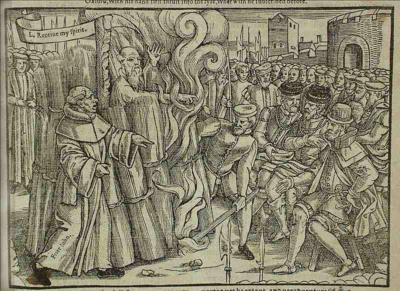Here is the record from Letters and Papers:
"Surrender of the monastery and all its possessions in cos. Essex, Midd., Herts, Camb., Line, Norf., Suff., Berks, Oxon, Bucks, Beds, Kent, Sussex, Surr., Soms., Dors., Hants., Wilts., and Glouc., and the city of London and elsewhere in England, Wales, and the marches thereof. 23 March, 31 Hen. VIII. Signed by Robert the abbot, and 17 others [See Deputy Keeper's Eighth Report, App. II. 47].
Seal broken. Docketed by Wm. Petre as recognised before him the same day.
R. O. 2. Pensions assigned by the commissioners for the dissolution of Waltham monastery, Essex, 24 March 31 Hen. VIII., viz.:—
Robt. Fuller, abbot, lands and possessions to the yearly value of 200l.; Thos. Warren, prior, 20l.; Robt. Wodlyff and Thos. Hawkyns, 9l.; Ric. Rede, Wm. Lyllye, chaunter, Geo. Solis, Robt. Parker, sexton, Hew Yonge, Humph. Marten, Miles Garrerd, and John Norres, 6l. 13s. 4d. each; Edm. Saunders, 10l. (altered by Cromwell from 6l. 13s. 4d., with the signature “Thomas Essex”); Edw. Storye, 8l.; John Saunders, John Holmested, Robt. Hull, and Edm. Freke, 5l. each. Certified by Thos. Mildemaye, auditor, and signed by Sir Ric. Ryche.
Pp. 2.
R. O. Petition of the inhabitants of the town and parish of Waltham to Mr. Ant. Deny, to obtain for them of the King the clock in the tower steeple which adjoins the west end of the abbey church and the east end of the parish church with five of the eight bells; for their said parish church, in which there has only been one bell since the days of Henry II., who altered the said church, being then a college, and made it an abbey, separating the same from the parish church that now is and reserving all the bells to the abbey. The abbey is now dissolved and they are unable for poverty to buy one good bell.
P. 1. Add. at the head: “To the right worshipful master Anthony Deny.” Endd."
Stephanie Mann has written an excellent article on the dissolution of Waltham Abbey on her blog Supremacy and Survival - click here to read it now.
Here is an extract from my book Tudor Places of Great Britain on Waltham Abbey:
Today, the Abbey Church, gatehouse and bridge, and a few ruins are all that remain of Waltham Abbey, an abbey whose origins dated back to the 11th century, when a church was re-founded at Waltham after Harold Godwin, Earl of Wessex, father of Harold II, was healed of paralysis after praying before the Holy Rood at Waltham. The church was refounded in 1177 as an Augustinian priory, as part of Henry II's penitence for the murder of Thomas Becket. It was raised to the status of an abbey in 1184 and became one of the most important monastic house of England.
The church is the resting place of King Harold II and the abbey library was home to the 13th century Waltham Bible. The church was a major site of pilgrimage in the medieval and Tudor periods. Waltham was the last abbey to be surrendered to the crown during the Dissolution of the Monasteries, and was dissolved in 1540 and granted to the Denny family. It was at this time that the monastic buildings and the parts of the church that stood east of the crossing were sadly demolished. Visitors to the church today, which is known as the Abbey Church of Waltham Holy Cross and St Lawrence, and which serves as the parish church of Waltham Abbey town, can still see the Norman nave, the 14th century Lady Chapel and west wall, and the 16th century west tower. It still has plenty of fine Norman architecture and is well worth a visit.
The gatehouse dates back to the 14th century as does “Harold's Bridge”, which crosses Cornmill Stream. The gatehouse's west wall has two beautiful arched gateways that are dressed in limestone: one for pedestrians and one for carriages. Also visible on the site are some remains of the cloister and chapter house walls, along with remains of a post-medieval house.
You can find out more about the church and abbey on the following websites:
- http://www.walthamabbeychurch.co.uk/
- http://www.english-heritage.org.uk/visit/places/waltham-abbey-gatehouse-and-bridge/
Sources
- 'Henry VIII: March 1540, 21-31', in Letters and Papers, Foreign and Domestic, Henry VIII, Volume 15, 1540, ed. James Gairdner and R H Brodie (London, 1896), pp. 150-181, 393 and 394. British History Online http://www.british-history.ac.uk/letters-papers-hen8/vol15/pp150-181.




A shame really ☹️
These monastic houses were a real loss, not only as great buildings but as social, communal and historical religious institutions. For 1500 years they had prayed for the local community, provided shelter and employment, kept the marking of the hours, served the community and been at the heart of religious life. Then within four years they were gone. Imagine the shock to the vast majority of ordinary people that had looked to them on the landscape as they closed their gates, their monks and abbot had to leave or in some cases were hung from the walls, especially in 1537, their bells ceased to ring out and the voices of chant and prayer fell silent. Imagine the devastating effect as eventually the building was dismantled, those who relied on being in service to the monastery lost their farms and tenancys and people were forced to beg instead in order to survive. Those who accused them of being too wealthy and corrupt never even thought about the how to replace the entire monastic system, just stole and misused its wealth. Even if some houses genuinely had problems, reforming that order was the way to go, but this was about greed by Cromwell and King Henry, a great land grab, not about corruption or reformation.
What a terrible loss!
Yes!